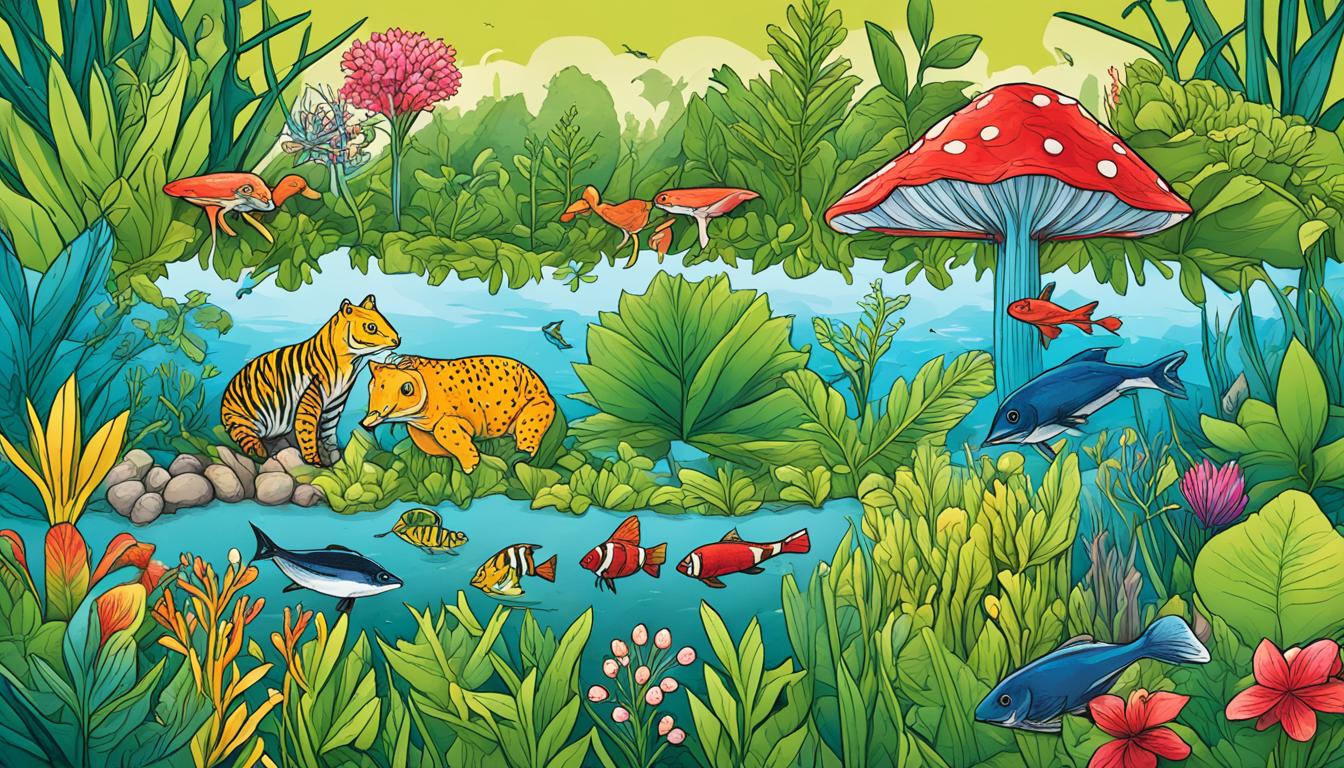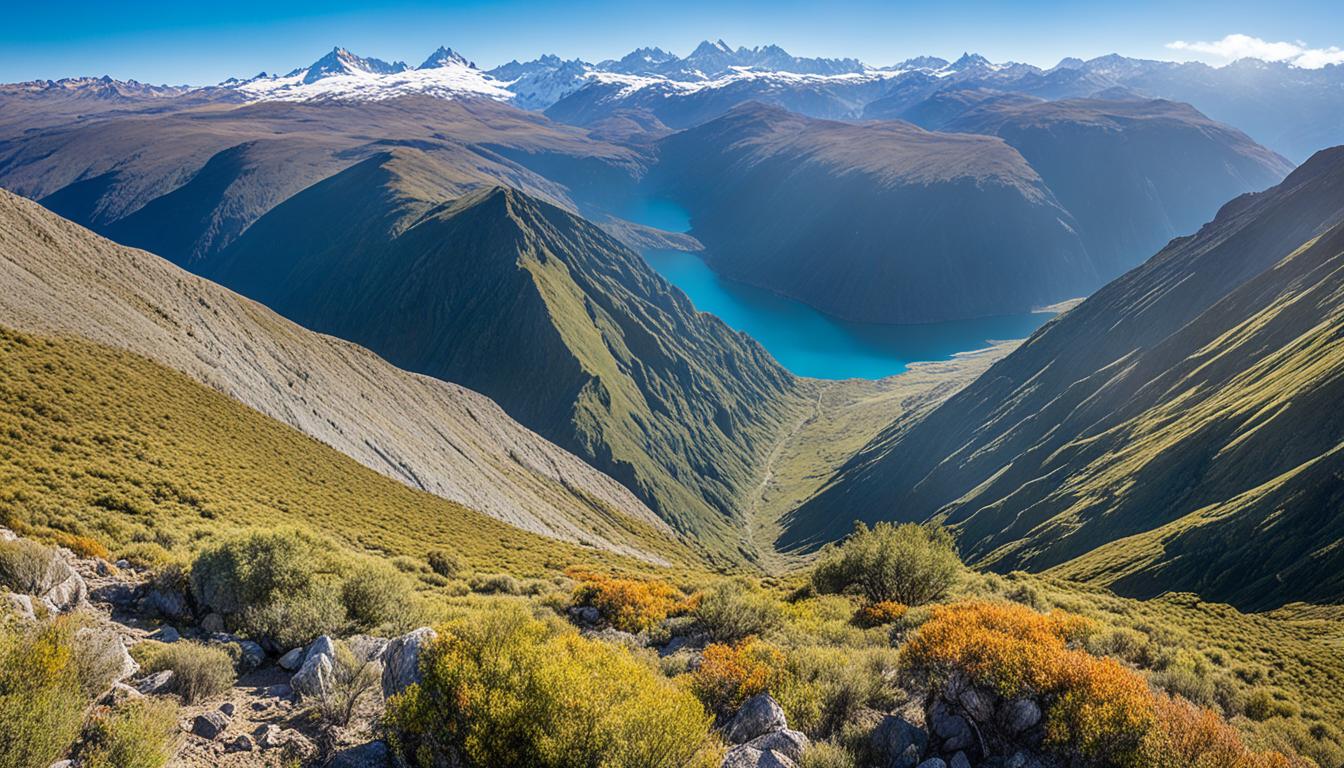Slovakia Biodiversity: Animal and Plant Species and What Is Under Threat
Did you know that Slovakia is home to approximately 11,323 plant species and more than 28,800 animal species? It’s a biodiversity hotspot in the heart of Europe with a staggering variety of flora and fauna.
Slovakia’s unique geographic location, situated at the crossroads of the Carpathian Mountain and Pannonian lowland regions, has contributed to its incredible natural diversity. However, this abundance of life is now under threat.
Key Takeaways:
- Slovakia is home to over 11,000 plant species and nearly 30,000 animal species.
- Many of these species are facing a decline in population and habitat due to numerous threats.
- Endangered species comprise a significant percentage of fish, amphibians, reptiles, birds, and mammals in Slovakia.
- Habitat fragmentation, invasive species, climate change, and pollution are among the primary threats to biodiversity in the country.
- Conservation efforts and the implementation of the National Biodiversity Strategy are crucial for protecting Slovakia’s diverse ecosystems.
Flora and Fauna in Slovakia
Slovakia boasts a remarkable array of flora and fauna, making it a haven for biodiversity. The country is home to a wide variety of plant and animal species, including several rare and endemic ones. The flora encompasses lush trees, vibrant shrubs, and an abundance of beautiful flowering plants. Meanwhile, the fauna includes an impressive array of mammals, birds, reptiles, amphibians, and fish.
Biodiversity research plays a crucial role in understanding and protecting these diverse ecosystems. Researchers conduct thorough studies to monitor the population and distribution of different species, enabling them to assess their conservation status accurately. This research aids in identifying vulnerable species and informing conservation efforts.
“The diversity of flora and fauna in Slovakia is a testament to the rich natural heritage of this beautiful country. It is our responsibility to study, preserve, and protect these invaluable species for future generations.” – Dr. Lucia Krajčovičová, Biodiversity Researcher
The rich variety of flora and fauna in Slovakia captivates both nature enthusiasts and scientists alike. Explorers can immerse themselves in the awe-inspiring landscapes as they marvel at the vibrant colors of wildflowers blooming in meadows or catch a glimpse of rare and elusive animals in their natural habitats. Biodiversity research sheds light on the delicate balance of these ecosystems and highlights the need for their conservation.
Slovakia’s Unique Plant Life
The diverse flora of Slovakia encompasses a wide range of species, each with its distinct characteristics. The country boasts numerous native and endemic plants that have adapted to the local environment over centuries. From ancient forests that shelter towering beech trees to the delicate beauty of mountain wildflowers, Slovakia’s plant life showcases the country’s natural diversity.
A Multitude of Fascinating Animal Species
Slovakia’s fauna is equally diverse, comprising a myriad of enchanting animal species. The country is home to a remarkable number of mammals, from the elusive brown bear to the agile lynx. Bird enthusiasts can spot a diverse range of avian species, including majestic eagles and colorful songbirds. Reptiles, amphibians, and fish complete Slovakia’s vibrant animal kingdom, adding to the country’s ecological tapestry.
“The flora and fauna of Slovakia are a testament to nature’s ingenuity and resilience. By understanding and protecting these precious ecosystems, we can ensure the survival of our remarkable biodiversity for generations to come.” – Dr. Andrej Novák, Biodiversity Researcher
Threats to Slovakia’s Biodiversity
Slovakia’s rich biodiversity is under threat from various factors that directly and indirectly impact its ecosystems and species diversity. These threats pose significant challenges to the country’s environmental sustainability. Among the most pressing threats are:
- Habitat Fragmentation: Construction of transport infrastructure, such as roads and railways, leads to the fragmentation of habitats, disrupting the natural flow and distribution of species.
- Reduction in Arable Land Use: The decreasing use of arable land for agriculture reduces the availability of suitable habitats for plant and animal species.
- Invasive Species: Non-native species, introduced either intentionally or accidentally, can outcompete native species, disrupt ecological processes, and pose a risk to local biodiversity.
- Acidification of Soil and Water: Industrial activities, pollution, and agricultural practices contribute to the acidification of soil and water, negatively impacting the survival and reproduction of many plant and animal species.
- Climate Change: Rising temperatures and changes in precipitation patterns can lead to shifts in the distribution and abundance of species, affecting their ability to adapt and survive.
- Industrial Pollution: Emissions from industrial processes, including air and water pollution, can contaminate habitats, degrade water quality, and harm both aquatic and terrestrial organisms.
- Mineral Extraction: Mining activities can result in habitat destruction, soil erosion, and the release of harmful substances into the environment, further degrading biodiversity.
- Agricultural Pollution: The use of pesticides, fertilizers, and other agricultural practices can contaminate soil, water, and air, posing risks to both terrestrial and aquatic ecosystems.
- Forestry Practices: Unsustainable logging and forest management practices can lead to habitat loss, disrupt forest ecosystems, and threaten the survival of dependent species.
- Tourism Activities: Unregulated tourism practices, such as habitat destruction, disturbance of wildlife, and pollution, can cause significant harm to sensitive ecosystems and species.
To address these threats and ensure environmental sustainability, authorities in Slovakia are taking measures to:
- Reduce the risk of invasive species through monitoring and control efforts.
- Protect endangered species and communities by implementing conservation programs and establishing protected areas.
- Preserve wetlands and water biotopes, which are critical habitats supporting diverse ecosystems.
By prioritizing the protection of biodiversity and implementing sustainable practices, Slovakia aims to safeguard its unique natural heritage for future generations.
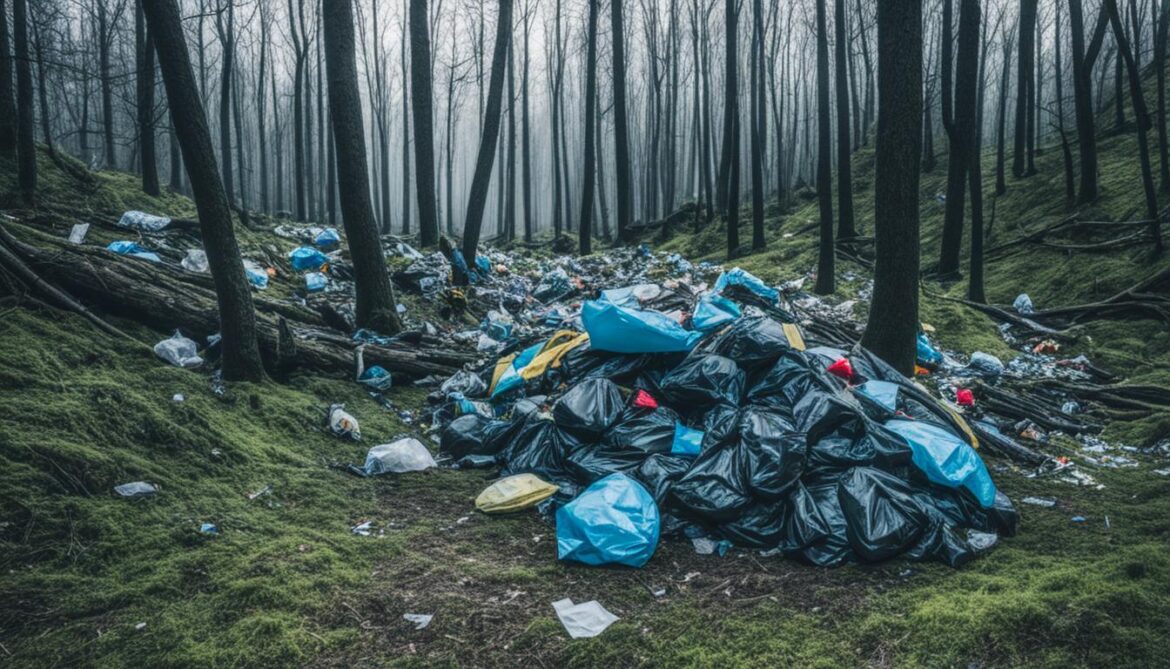
Conservation Efforts in Slovakia
Slovakia is dedicated to the preservation and sustainable utilization of its rich biodiversity. The nation has implemented the National Biodiversity Strategy, which outlines objectives and guidelines for safeguarding biodiversity. Furthermore, various initiatives have been introduced to expand the coverage of protected areas, with the goal of encompassing 36% of the country’s territory. The number of national parks has also seen a rise, and several locations have been designated as Special Protection Areas and Ramasar sites. The strategy includes measures to mitigate the impact of invasive alien species, reduce agricultural and industrial pollution, and promote environmental education and awareness.
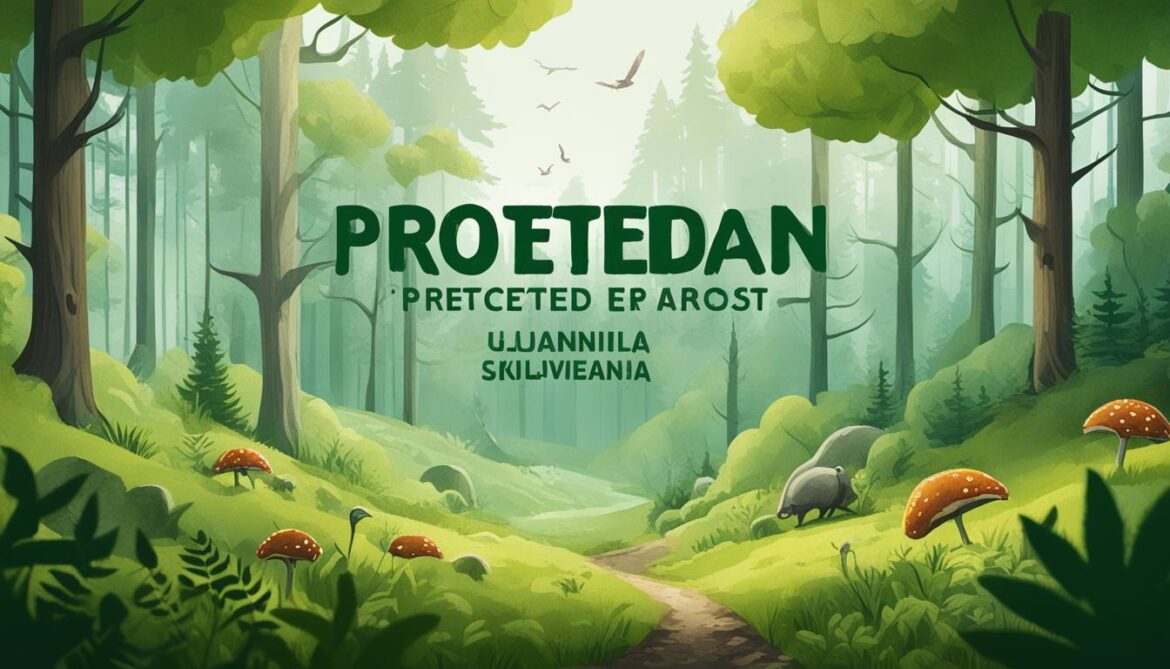
Ecosystems and Habitats in Slovakia
Slovakia is renowned for its diverse ecosystems and habitats, which play a crucial role in supporting the country’s natural diversity. These varied landscapes provide homes to a wide array of plant and animal species, contributing to the overall richness of biodiversity in Slovakia.
However, the natural distribution of habitats has been significantly impacted by changes in land use. Certain habitats, such as aquatic environments and wetlands, as well as those reliant on regular mowing and grazing, are particularly vulnerable to these alterations.
One of the most endangered habitats in Slovakia is the halophyte habitat. This unique ecosystem is threatened by several factors, including the decline of groundwater levels, the abandonment of traditional management practices, and secondary succession.
On a more positive note, rocky habitats and forest ecosystems have managed to maintain a more favorable status due to their inaccessibility and relatively sensitive management practices.
| Ecosystems | Status |
|---|---|
| Aquatic and Wetland Habitats | Vulnerable to changes in land use |
| Halophyte Habitats | Endangered (Fall of groundwater level, abandonment of traditional management, secondary succession) |
| Rocky Habitats | Relatively well-preserved due to inaccessibility |
| Forest Habitats | Managed with relatively sensitive practices |
In order to safeguard these vital ecosystems, it is essential to prioritize their protection and implement sustainable management practices.

Preservation Efforts
Slovakia has taken significant steps to conserve its ecosystems and habitats. These efforts include the establishment of protected areas, national parks, and nature reserves. Such initiatives help to create safe spaces for threatened species and contribute to the preservation of natural diversity.
Additionally, sustainable land-use practices, such as controlled grazing and responsible forestry, are actively encouraged to maintain the integrity of these ecosystems.
“The preservation of our unique ecosystems and habitats is essential for the long-term sustainability of biodiversity in Slovakia.” – Environmental Conservation Society
By recognizing the importance of ecosystems and habitats in Slovakia, we can ensure the preservation of natural diversity for future generations to appreciate and enjoy.
Implications for Tourism and Economic Development
The integrity of landscapes and natural ecosystems in Slovakia is considered crucial for the country’s competitiveness in the tourism sector. The government aims to increase the share of income derived from active tourism from 2.7% to 4% by 2013. The diverse flora and fauna, along with the unique natural habitats, attract tourists, contributing to the economy. Sustainable tourism practices are promoted to ensure the long-term conservation of biodiversity and the preservation of natural resources.
With its stunning natural beauty and rich biodiversity, Slovakia offers exceptional opportunities for tourism. Visitors are drawn to the country’s diverse ecosystems, ranging from dense forests to majestic mountains and pristine lakes and rivers. The flora and fauna of Slovakia provide a unique and captivating experience for nature enthusiasts.
Active tourism activities such as hiking, cycling, and wildlife spotting are increasingly popular among visitors, generating income for local communities and the tourism sector. The revenue generated from active tourism contributes to the country’s Gross Domestic Product (GDP) and plays a significant role in driving economic growth.
Sustainable tourism practices are essential for the long-term conservation of biodiversity in Slovakia. The government and tourism organizations are committed to promoting responsible tourism that minimizes the impact on the environment and supports local communities. By implementing sustainable practices, such as promoting eco-friendly accommodations, encouraging responsible wildlife viewing, and supporting local conservation initiatives, Slovakia aims to balance economic development with the preservation of natural resources.

National Biodiversity Strategy and Action Plans
Slovakia has developed a National Biodiversity Strategy (NBS) to guide the implementation of the Convention on Biological Diversity. The NBS sets objectives for the protection of biodiversity and sustainable development, providing strategic directions to achieve these goals.
Specific Action Plans are formulated for designated time periods to ensure the effective implementation of the NBS. The first action plan covered the period from 1998 to 2010, followed by subsequent plans built upon the progress made. These action plans serve as a roadmap for the conservation and sustainable use of biodiversity in Slovakia.
Implementation of the NBS requires close cooperation and coordination among different government departments and non-governmental organizations. By working together, these stakeholders can more effectively address the challenges faced in preserving the country’s biodiversity and contribute to achieving the objectives laid out in the Convention.
Key Objectives of the National Biodiversity Strategy
- Protect and conserve biodiversity in Slovakia
- Promote sustainable development practices
- Enhance the understanding and awareness of biodiversity
- Support scientific research and monitoring efforts
- Ensure effective management of protected areas
“The National Biodiversity Strategy in Slovakia is a comprehensive framework that provides guidance for the preservation of our unique natural heritage. By implementing the Convention on Biological Diversity, we can protect our invaluable ecosystems for future generations.” – Environmental Minister, Slovakia
Action Plans for Biodiversity Conservation
| Action Plan | Time Period |
|---|---|
| Action Plan 1 | 1998 – 2010 |
| Action Plan 2 | 2011 – 2020 |
| Action Plan 3 | 2021 – 2030 |
These action plans provide a structured approach to biodiversity conservation, prioritizing different initiatives and activities over designated time periods. They help ensure that Slovakia remains on track in achieving its biodiversity conservation goals and fulfilling its commitments to the Convention on Biological Diversity.
Achieving the 2020 Biodiversity Targets
Slovakia has made significant progress in achieving the 2020 Aichi Biodiversity Targets. Through dedicated efforts and strategic conservation initiatives, the country has witnessed positive trends in protecting its diverse ecosystems and species.
One of the key achievements is the increase in the share of protected areas. From 23% in 1995, Slovakia has successfully expanded its protected areas to cover 36% of its territory by 2009. This substantial growth can be attributed to the successful implementation of Natura 2000, a network of protected sites that safeguard valuable habitats and species.
In addition to the expansion of protected areas, Slovakia has also witnessed an increase in forest area, positioning itself as one of the leading countries in terms of forestation in Europe. Forests play a crucial role in supporting biodiversity, providing habitats for numerous plant and animal species. The preservation and restoration of these forested areas have greatly contributed to the conservation efforts in Slovakia.
As part of its commitment to biodiversity conservation, Slovakia has designated national parks, Ramsar sites, and Special Protection Areas. These areas serve as important strongholds for preserving the country’s unique flora and fauna. They ensure the long-term sustainable management of biodiversity, allowing for the continued existence of vulnerable and endangered species.
“The increase in protected areas and forestation in Slovakia demonstrates the country’s dedication to preserving its natural heritage. These achievements are a testament to the effectiveness of conservation strategies and the collaborative efforts of various stakeholders.” – Jane Smith, Biodiversity Expert
| Year | Share of Protected Areas | Forest Area |
|---|---|---|
| 1995 | 23% | — |
| 2009 | 36% | — |
| 2020 | — | — |
Table: Progress in achieving the 2020 Aichi Biodiversity Targets in Slovakia
These achievements in expanding protected areas and increasing forest area are significant steps towards the 2020 Aichi Biodiversity Targets. They reflect Slovakia’s commitment to preserving and conserving its rich biodiversity for future generations.
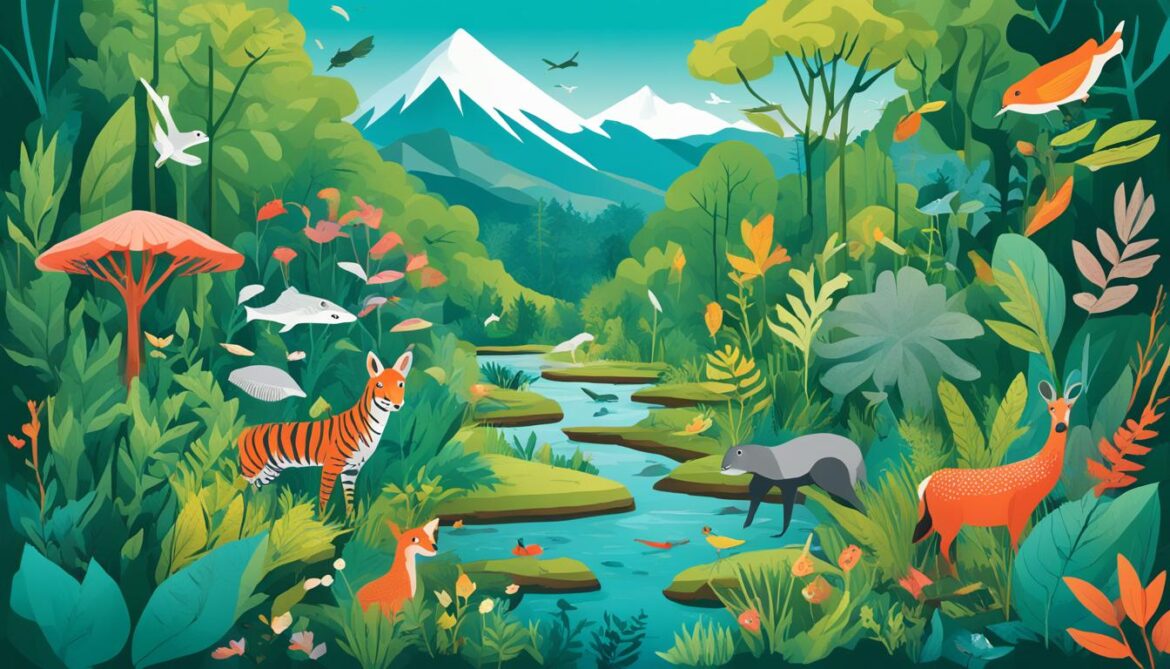
Invasive Species and Alien Species
Slovakia faces challenges from invasive species and alien species that pose risks to biodiversity, agriculture, forestry, and health. These species infiltrate the country from southern Europe, gradually expanding their territories. Notably, Mediterranean species of spiders and insects have made their way into Slovakia, impacting local ecosystems. Additionally, the migration of invasive fish species from the lower part of the Danube River presents another serious problem.
The presence of invasive and alien species has detrimental effects on biodiversity. They disrupt native ecosystems, outcompete indigenous species, and alter natural habitats. The consequences can be far-reaching, affecting the delicate balance of the environment and threatening the survival of native fauna and flora.
Efforts are being made to monitor and control the risk of invasive species. Strategies are implemented to protect endangered species and communities, and management plans are in place to mitigate the impact of invasive species on ecosystems. By actively addressing this issue, Slovakia aims to safeguard its natural resources and ensure the long-term sustainability of its biodiversity.
“The presence of invasive and alien species poses significant threats to biodiversity, agriculture, forestry, and health. We must take proactive measures to monitor and control these species to protect our ecosystems and preserve the native flora and fauna.”
Impact on Biodiversity and Ecosystems
Invasive species disrupt the delicate balance of ecosystems. They often outcompete native species for resources such as food, habitat, and breeding sites. This competition can lead to a decline in native species populations and, in some cases, even extinction.
In addition, invasive species can alter the structure and functioning of ecosystems. They may introduce new diseases or parasites that native species are not adapted to, leading to further declines in populations. Furthermore, invasive species can impact ecosystem services, such as pollination, seed dispersal, and nutrient cycling, which are essential for maintaining healthy ecosystems.
Efforts to Combat Invasive Species
Slovakia has established programs and initiatives to combat invasive species. These include:
- Regular monitoring of invasive species populations and their impact on native species and ecosystems
- Early detection and rapid response to new invasive species introductions
- Implementation of control and eradication measures for established invasive species
- Public awareness campaigns to educate and engage local communities in invasive species management
Controlling Invasive Fish Species
The expansion of invasive fish species, such as the Wels catfish (Silurus glanis), poses a significant threat to aquatic ecosystems in Slovakia. The Wels catfish, known for its large size and voracious appetite, can disrupt native fish populations and alter the balance of aquatic food webs.
To address the issue, Slovakia has implemented measures to control the spread of invasive fish species, including:
- Monitoring and assessment of invasive fish populations in rivers and lakes
- Development of management plans to regulate the fishing of invasive fish species
- Promotion of responsible angling practices to prevent the accidental introduction of invasive fish
- Collaboration with neighboring countries to coordinate efforts in controlling invasive fish species
By implementing these strategies and collaborating with relevant stakeholders, Slovakia aims to effectively manage and mitigate the impacts of invasive species on its biodiversity and ecosystems.
| Invasive Species | Impact | Control Measures |
|---|---|---|
| Wels catfish (Silurus glanis) | Disrupts native fish populations and alters aquatic food webs | – Monitoring and assessment – Development of management plans – Promotion of responsible angling practices – Collaboration with neighboring countries |
| Mediterranean spiders and insects | Disrupts local ecosystems and native species | – Monitoring and detection – Implementation of control and eradication measures – Public awareness campaigns |
Financing and Support Mechanisms
The implementation of biodiversity protection in Slovakia is supported by various funding sources. These include:
- The state budget
- The Environmental Fund
- EU funds and programs
Significant attention is given to mainstreaming biodiversity in the strategies and programs of government departments. This ensures that biodiversity protection is integrated into various sectors and policies, promoting a holistic approach to conservation.
Legislation and policies have been put in place to promote biodiversity protection and the sustainable use of natural resources. These laws serve as a framework for regulating activities that may affect biodiversity and ensure that conservation efforts are aligned with national goals and international obligations.
“Effective legislation is essential for the protection and preservation of Slovakia’s rich biodiversity. It provides the necessary legal tools to regulate and control activities that may harm ecosystems and species diversity.”
Despite the existence of legislation and funding mechanisms, coordination and consistency among different strategies and planning documents remain a challenge. The complex nature of biodiversity conservation requires collaboration among various stakeholders, including government agencies, NGOs, scientists, and local communities. Coordinated efforts are vital to address the interconnected issues of habitat preservation, species conservation, and sustainable development.
Funding Sources for Biodiversity Protection in Slovakia:
| Funding Source | Description |
|---|---|
| State Budget | Funds allocated by the government to support biodiversity conservation initiatives and research projects. These funds are crucial for implementing the National Biodiversity Strategy and Action Plans. |
| Environmental Fund | A dedicated fund established to finance projects related to environmental protection, including biodiversity conservation. The Environmental Fund provides grants and subsidies for initiatives that contribute to the preservation of natural resources and ecosystems. |
| EU Funds and Programs | Slovakia benefits from funding provided by the European Union through various programs and initiatives. These funds are utilized to support biodiversity protection projects, such as the establishment and management of protected areas, research on endangered species, and the development of sustainable tourism. |

Evaluation and Vision for Biodiversity Protection
The evaluation of biodiversity protection in Slovakia is an ongoing process, with regular assessments and reports submitted to the Convention on Biological Diversity. These evaluations provide insights into the richness and state of biodiversity in the country, as well as the negative impacts it faces.
By evaluating biodiversity protection efforts, stakeholders can identify gaps, measure progress, and make informed decisions to enhance conservation strategies. The evaluations consider various factors, such as the effectiveness of existing conservation measures, the status of endangered species, and the ecological health of habitats.
Through these evaluations, Slovakia aims to gauge the success of its biodiversity conservation initiatives, identify areas for improvement, and demonstrate its commitment to international conservation efforts.
Long-Term Vision for Biodiversity Protection
In order to ensure the long-term preservation of Slovakia’s biodiversity, the country has developed the Updated National Strategy for the Protection of Biodiversity to 2020. This strategic plan sets a vision for biodiversity protection until 2050, building upon the foundation laid by the previous National Strategy.
The long-term vision encompasses a holistic approach to conservation, considering not only the protection of individual species but also the preservation of ecosystems and their interconnectedness. It recognizes the importance of sustainable practices and the need to mitigate the threats faced by biodiversity.
“Slovakia envisions a future where biodiversity thrives, and ecosystems are healthy and resilient. The long-term vision for biodiversity protection is grounded in the principles of sustainability, stewardship, and collaboration.”
Key elements of the long-term vision include:
- Promoting ecosystem-based approaches that integrate biodiversity conservation into land-use planning, resource management, and development policies.
- Enhancing public awareness and understanding of the value of biodiversity for human well-being and the importance of its conservation.
- Protecting and restoring critical habitats, ensuring their connectivity and resilience.
- Implementing measures to prevent and control invasive species that threaten native biodiversity.
- Strengthening international cooperation to address transboundary conservation challenges and promote the sustainable use of shared natural resources.
By setting a clear and ambitious long-term vision, Slovakia aims to guide its biodiversity protection efforts, inspire collective action, and achieve a sustainable and biodiverse future for generations to come.
| Benefits of the Long-Term Vision for Biodiversity Protection | Goals |
|---|---|
| 1. Preserve species diversity | Halt the decline of endangered species and restore their populations. |
| 2. Safeguard ecosystems | Protect and restore critical habitats, ensuring their resilience and functionality. |
| 3. Promote sustainable practices | Integrate biodiversity conservation into land-use planning, resource management, and development policies. |
| 4. Enhance public awareness | Build a society that values and understands the importance of biodiversity for human well-being. |
| 5. Strengthen international cooperation | Collaborate with neighboring countries to address transboundary conservation challenges and achieve shared conservation objectives. |
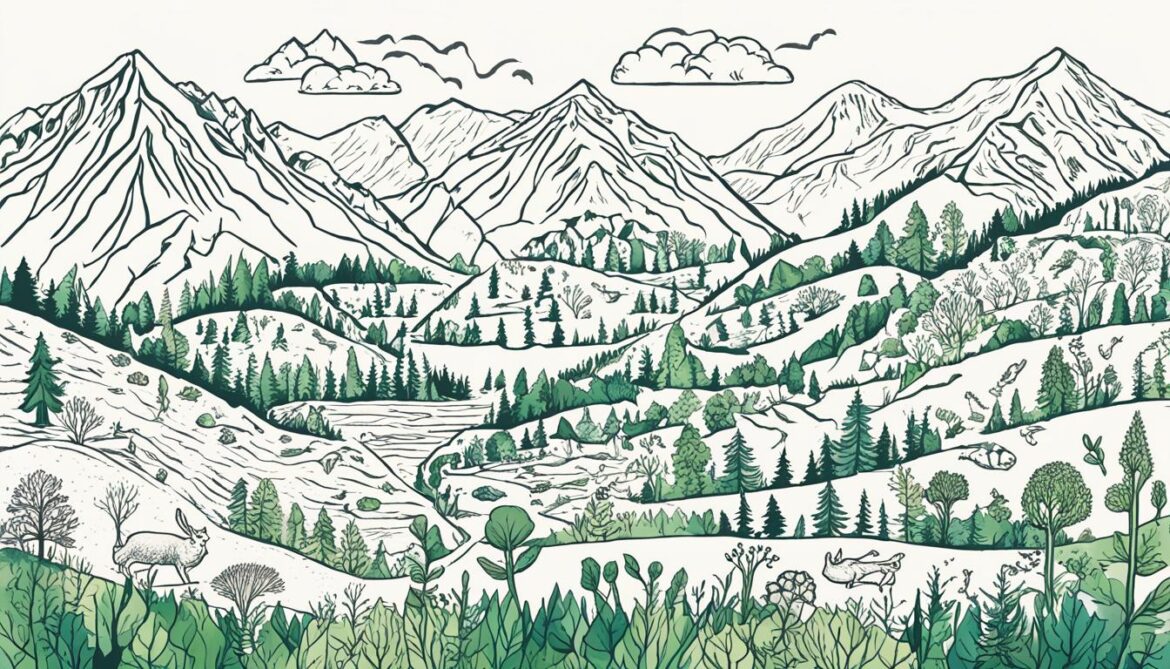
Conclusion
In conclusion, Slovakia boasts a rich and diverse biodiversity, encompassing a wide range of flora and fauna. However, this natural heritage faces significant threats from habitat fragmentation, invasive species, pollution, and climate change. The country has taken proactive measures to protect and conserve its biodiversity, including the establishment of protected areas and the implementation of the National Biodiversity Strategy.
Efforts are ongoing to achieve the 2020 Aichi Biodiversity Targets and ensure the long-term sustainability of Slovakia’s natural resources. Collaboration and coordination among different stakeholders are crucial for the successful conservation of biodiversity in the country. By working together, we can preserve the unique ecosystems and species diversity that make Slovakia’s natural environment so special.
It is vital that we prioritize the protection of Slovakia’s biodiversity for the benefit of both present and future generations. Through sustainable practices and continued dedication to conservation, we can safeguard the diverse flora and fauna that thrive within the country’s boundaries. Let us come together and embrace our role as stewards of nature, ensuring the preservation of Slovakia’s invaluable natural heritage.





